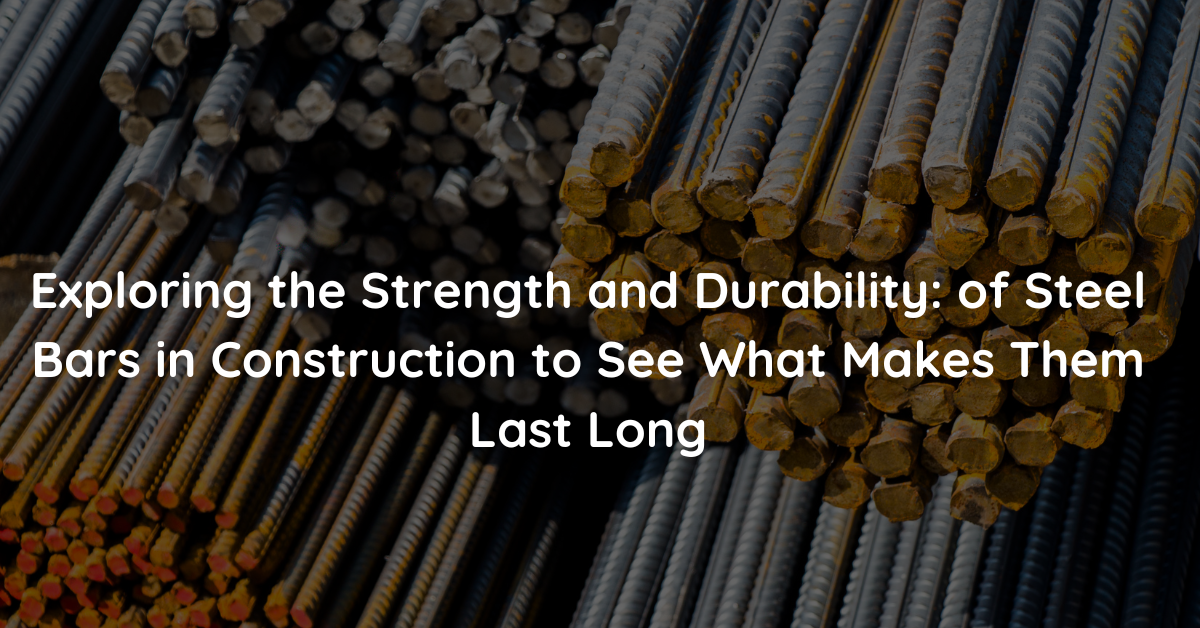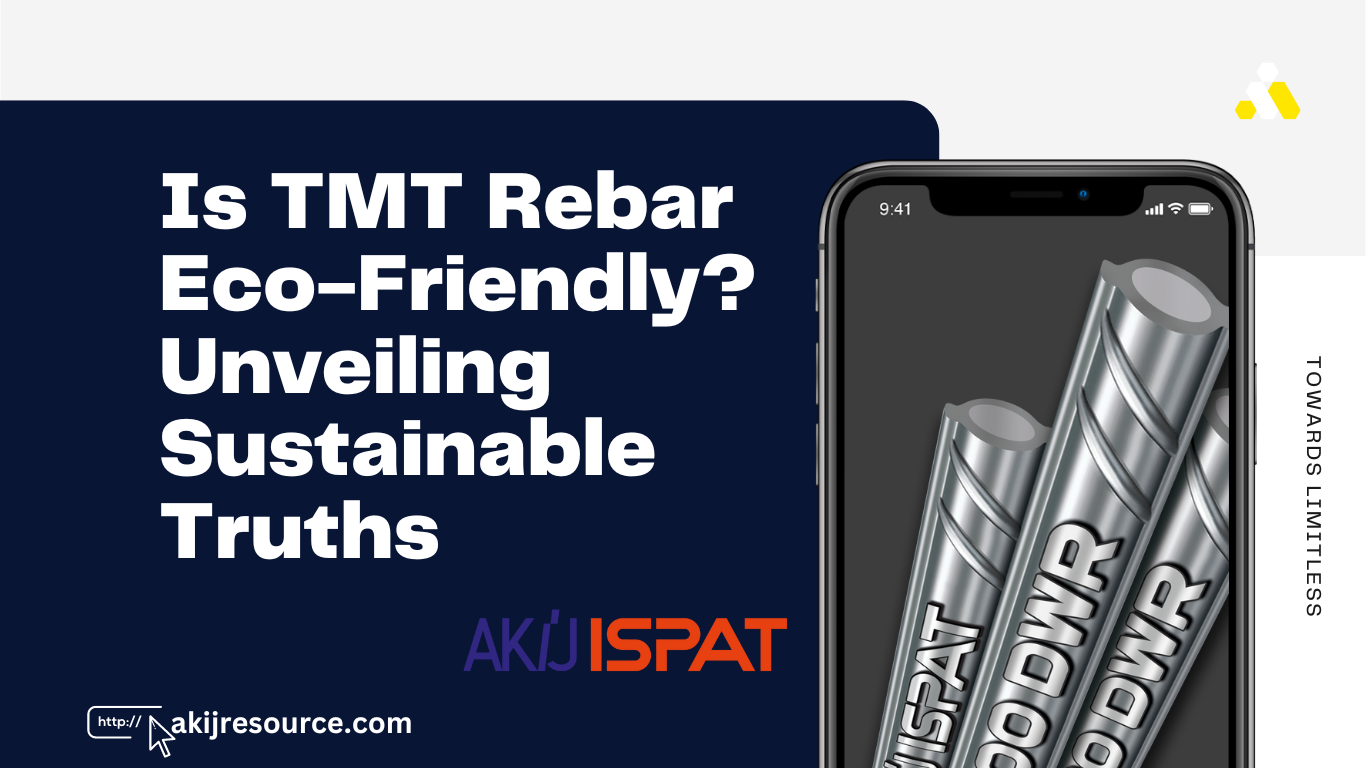TMT rebar boasts superior strength compared to mild steel. It’s specifically engineered for enhanced durability and resistance. Additionally, TMT rebar is also known for its excellent welding properties. Welding rebar insights reveal that TMT rebar’s composition and manufacturing process make it highly compatible for welding, resulting in strong and secure connections. This feature makes TMT rebar a top choice for construction projects that require reliable and long-lasting structural support.
Understanding the differences between TMT rebar and mild steel is crucial for anyone involved in construction or engineering. TMT, or Thermo-Mechanically Treated bars, undergo a unique manufacturing process that significantly enhances their yield strength, making them more suitable for reinforcing concrete in construction projects.
On the other hand, mild steel, known for its ductility, is often used in less structurally demanding applications. The choice between these two materials depends on the specific needs of a project, including factors like environmental conditions, load requirements, and budget constraints. Selecting the right type of steel can ensure the longevity and safety of a structure, making knowledge of their distinct properties invaluable for builders and engineers alike.
Introduction to TMT And Mild Steel
Introduction to TMT and Mild Steel explores the core differences and strengths between two essential construction materials: TMT Rebar and Mild Steel. Builders and engineers often choose between these based on project needs. Understanding their unique properties helps in making informed decisions for stronger, more durable structures.
The Basics Of TMT Rebar
TMT Rebar, or Thermo-Mechanically Treated Rebar, stands out in construction. Its making involves high-temperature processing followed by rapid cooling. This process grants TMT Rebar superior strength and flexibility. Ideal for buildings needing resistance against earthquakes and other natural disasters.
- High tensile strength: It supports heavy loads.
- Corrosion resistance: Lasts longer in harsh weather.
- Better flexibility: Essential for earthquake-prone areas.
Understanding Mild Steel
Mild Steel is a carbon steel variant with low carbon content. Its simplicity in composition makes it highly weldable and malleable. Often used in everyday objects and simple construction projects. Its affordability and availability make it a popular choice for many builders.
- Easy to shape: Good for custom designs.
- Cost-effective: Budget-friendly for large projects.
- Weldability: Joins easily with other metals.
Each material serves distinct purposes in construction. The choice between TMT Rebar and Mild Steel depends on project requirements, budget, and desired lifespan of the structure. Knowing their basics helps in selecting the right material for the job.

Credit: m.youtube.com
Composition And Properties
Composition and Properties are crucial for understanding the strength of construction materials. Builders choose between TMT rebar and mild steel. Each has unique features that make it suitable for different uses. Let’s explore what these metals are made of and their characteristics.
Material Composition Of Tmt Rebar
TMT rebar, or Thermo-Mechanically Treated rebar, is a high-strength material. Its making involves quenching and tempering. This creates a hard outer shell with a soft core. Here’s what’s inside:
- Carbon: Low to medium
- Manganese: Improves strength
- Sulphur and Phosphorus: Kept low
This combo gives TMT rebar superior properties. These include high yield strength and ductility.
Material Composition Of Mild Steel
Mild steel is a popular type of carbon steel. It’s different from TMT rebar. Here’s what it contains:
- Carbon: Usually under 0.25%
- Manganese: Aids in forming
- Silicon, Sulphur, and Phosphorus: Present in small amounts
This composition makes mild steel easy to shape. It is less brittle than high-carbon steels.
Physical Characteristics
TMT rebars and mild steel are vital materials in construction. They have distinct physical traits. These traits impact their performance and usage. Let’s explore the differences in surface, flexibility, and ductility.
Surface Differences
The surface of TMT rebars shows unique ribs. These ribs create a strong bond with concrete. Mild steel is smoother. It has fewer ribs compared to TMT rebars. This makes its grip with concrete weaker.
Flexibility And Ductility
TMT rebars are highly flexible. They bend without breaking. This makes them ideal for areas prone to earthquakes. Mild steel is less flexible. It can crack under high stress. TMT’s high ductility also allows for better safety in construction.
Tensile Strength And Durability
Tensile strength and durability are crucial for construction materials. These qualities define how well a structure will withstand forces and weathering over time. TMT rebars and mild steel have distinct differences in these aspects.
TMT Rebar Tensile Strength
TMT rebars boast high tensile strength, making them ideal for modern structures. This strength comes from a unique manufacturing process. Here’s how TMT rebars stand out:
- Quenching: Rapid cooling increases strength.
- Tempering: Heat treatment enhances toughness.
- Deformation: Surface patterns improve grip in concrete.
TMT rebars can resist higher stress and strain, leading to longer life for buildings.
Mild Steel Durability Factors
Mild steel is known for its ductility and weldability. Here are key factors affecting its durability:
| Factor | Impact on Durability |
|---|---|
| Carbon Content | Lower carbon means more flexibility. |
| Corrosion Resistance | Prone to rust, needs protective coatings. |
| Welding Quality | Good welds ensure structural integrity. |
While mild steel is easy to shape, its resistance to wear and corrosion is less than TMT rebars.
Corrosion Resistance
Corrosion Resistance plays a key role in the longevity and safety of steel structures. It defines how well a material can withstand environmental factors without degrading. TMT rebar and mild steel are common construction materials. Each has different reactions to corrosion.
TMT Rebar Corrosion Mechanics
TMT rebars have a unique manufacturing process. This gives them high corrosion resistance. The surface of TMT bars is tough. This is due to rapid quenching. The core remains soft. This gives flexibility. TMT rebars also receive a water-cooling treatment. This creates a tempered martensite outer layer. It protects the inner core from rust.
- Quenching: This process makes the outer layer hard.
- Tempering: This step follows quenching. It gives strength.
- Cooling: Finally, the rebar cools down. This locks the structure.
Mild Steel Vulnerability
Mild steel, unlike TMT, lacks corrosion-resistant features. It has more carbon. This makes it tougher but less ductile. Without coatings, mild steel easily rusts. Its surface does not have a protective layer. It is vulnerable in damp environments. Buildings near the sea suffer the most. Salty air speeds up the rusting process.
| Feature | TMT Rebar | Mild Steel |
|---|---|---|
| Corrosion Resistance | High | Low |
| Carbon Content | Low | High |
| Flexibility | High | Low |
| Protective Layer | Yes | No |
Maintaining the integrity of steel in construction is essential. TMT rebars stand out. They offer better protection against corrosion than mild steel. This makes them a preferred choice for safer, longer-lasting structures.
Cost-effectiveness And Availability
Choosing the right steel for construction is crucial. It impacts cost and availability. TMT Rebar and Mild Steel are popular choices. Let’s explore their cost-effectiveness and availability.
Price Comparison
The cost of TMT Rebar and Mild Steel varies. Factors include market demand and quality. Overall, TMT Rebar is seen as a cost-effective option. It offers high strength with less quantity needed. This results in lower overall project costs.
| Type | Average Price (per ton) |
|---|---|
| TMT Rebar | $550 |
| Mild Steel | $500 |
Note: Prices can change based on location and supplier.
Market Availability
- TMT Rebar is widely available. It’s used globally in construction.
- Mild Steel is also easily found. It’s used in various industries.
Both types are accessible. Yet, TMT Rebar’s demand makes it more present in markets. This ensures steady supply for construction projects.
Applications In Construction
Construction relies on strong materials. Builders choose materials based on project needs. Two popular choices are TMT rebar and mild steel. Each serves different functions in construction.
TMT Rebar In Modern Structures
TMT rebar, or Thermo-Mechanically Treated rebar, is a modern marvel. It has a tough outer core and a soft inner core. This design gives it high tensile strength and ductility. These features make TMT rebar ideal for high-rise buildings, bridges, and flyovers. It resists earthquakes and harsh weather. TMT rebar is essential for modern construction because it adapts to innovative designs.
- High-rise Buildings: TMT’s strength supports skyscrapers.
- Bridges: It handles dynamic loads and vibrations.
- Industrial Structures: TMT withstands heavy machinery stress.
Mild Steel Traditional Uses
Mild steel, with its lower carbon content, is less rigid. It is easier to cut and weld than TMT rebar. Mild steel has been used for decades in various construction areas. Its flexibility makes it suitable for projects where high ductility is not a priority.
- Residential Projects: Mild steel is used in home construction.
- Decorative Structures: Its malleability makes it perfect for ornamental designs.
- General Fabrication: Mild steel is ideal for everyday objects like fences and gates.

Credit: www.birlatmtsteel.com
Environmental Impact
Understanding the environmental impact of building materials is key. We compare TMT rebar strength and mild steel. Let’s explore their manufacturing and life cycle.
Eco-friendly Manufacturing
TMT rebars have an edge in green production. They use less energy to make. This cuts down carbon emissions. Mild steel also tries to be eco-friendly. But TMT leads the way.
TMT production uses advanced technology. This tech reduces waste and uses resources well. Mild steel’s process is older. It can’t match TMT’s efficiency.
Recyclability And Sustainability
Both TMT rebars and mild steel are recyclable. This makes them sustainable choices for construction. They can be melted down and reused. This saves raw materials and energy.
- TMT rebars are highly recyclable. They keep their strength after recycling.
- Mild steel is also recyclable. But it may lose some strength when recycled.
Choosing TMT or mild steel makes a positive environmental impact. It reduces the need to mine new material. This helps protect our planet.
The Verdict
The Verdict on TMT rebar and mild steel is clear. Builders and engineers often debate their merits. Both materials have unique strengths and applications in construction. Yet, recent trends show a preference for one. Let’s delve into their properties to determine the best option for construction needs.
Assessing The Best Option
Different projects require different materials. TMT rebar stands out for its superior qualities. It’s known for high tensile strength and better ductility. Mild steel, on the other hand, is more malleable. It’s easier to cut and shape. TMT rebar also excels in resistance to corrosion and earthquakes. This makes it a go-to for structures needing resilience.
- TMT Rebar: High tensile strength, ductility, corrosion resistance.
- Mild Steel: Malleability, ease of handling.
For heavy-duty construction, TMT rebar is often the preferred choice. It ensures longevity and safety. Mild steel may be suitable for less demanding applications. Its ease of use makes it a favorite for smaller projects.
Future Of Construction Materials
Construction materials evolve with technology. TMT rebar is at the forefront of this innovation. Its blend of strength and flexibility is hard to match. As we build higher and on more challenging terrains, TMT’s attributes become vital. It’s poised to play a big role in future construction.
| Material | Strength | Ductility | Corrosion Resistance | Usability |
|---|---|---|---|---|
| TMT Rebar | High | High | Excellent | Good |
| Mild Steel | Moderate | Moderate | Good | Excellent |
In conclusion, TMT rebar’s advantages make it a leader in modern construction. It supports safe, durable, and innovative building designs. Mild steel also has a place, particularly where flexibility is key. As we look to the future, TMT’s role seems set to grow even more.
Credit: www.quora.com
Frequently Asked Questions
Is Rebar Stronger Than Mild Steel?
Rebar is not inherently stronger than mild steel but has a higher tensile strength, making it better for reinforcing concrete.
What Is The Difference Between Tmt Bar And Mild Steel?
TMT bars are thermo-mechanically treated for higher strength and flexibility, unlike mild steel, which is less strong but more ductile. TMT bars resist corrosion better, making them ideal for construction, while mild steel is often used for general fabrications due to its affordability.
What Is The Strength Of Tmt Bar?
The strength of a TMT bar typically ranges from 415 N/mm² to 500 N/mm². This high strength enhances the durability and safety of structures.
What Is The Difference Between Tmt And Normal Steel?
TMT steel features a unique thermo-mechanical treatment, providing enhanced strength, ductility, and corrosion resistance compared to normal steel, which lacks these advanced processing techniques.
Conclusion
Understanding the differences between TMT rebar and mild steel is crucial for any construction project. TMT bars offer enhanced strength, superior ductility, and better corrosion resistance, making them the ideal choice for modern structures. Selecting the right type of reinforcement can significantly impact the longevity and safety of a building.
For those prioritizing durability and performance, TMT rebar is the clear frontrunner over mild steel.








